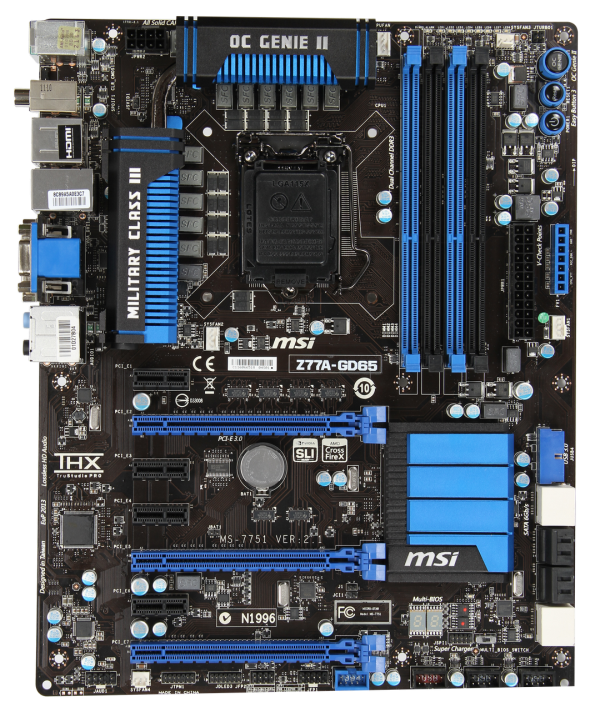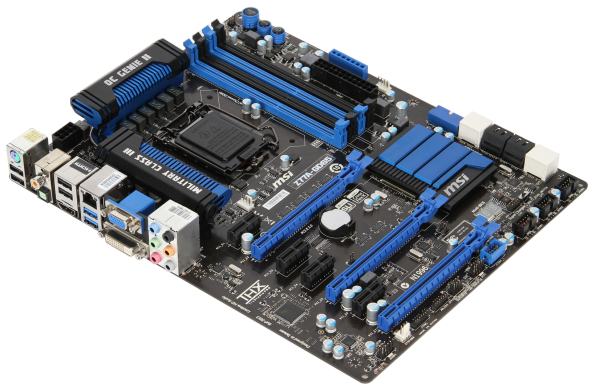Intel Z77 Panther Point Chipset and Motherboard Preview – ASRock, ASUS, Gigabyte, MSI, ECS and Biostar
by Ian Cutress on April 8, 2012 12:00 AM EST- Posted in
- Motherboards
- Intel
- Biostar
- MSI
- Gigabyte
- ASRock
- Asus
- Ivy Bridge
- ECS
- Z77
MSI Z77A-GD65—Visual Inspection
Whenever it comes to a motherboard comparison involving ASUS, Gigabyte or ASRock against an MSI board, the MSI board always tends to show a strong result—either in terms of price, performance or features. So when it comes to the new batch of motherboards for Ivy Bridge, it is fair to say that I expect a strong showing from MSI. For this preview, we have their Z77A-GD65, which will be one behind their future released GD80 that got attention back at CES for being Thunderbolt equipped.
The Z77A-GD65 is another motherboard in this roundup that comes in a black and blue livery. This time MSI have more of an excuse than others do as they have been using it for a fair while now. Using what is essentially a 10 + 2 phase power delivery, MSI are using somewhat beefier heatsinks than their rivals, connecting both via a heatpipe. The socket area is right up against Intel's minimum requirements from left to right, but there is some room to maneuver big air coolers from top to bottom. Around the socket there are at least four fan headers to use: one 4-pin CPU header between the top VRM and the memory slots, a 4-pin system fan header just the other side of the memory slots, a 4-pin to the bottom left of the socket area, and another 4-pin beside the 24-pin ATX power connector. A fifth fan header can be found at the bottom of the board.
Along the right hand side, we have the standard MSI trio of power/reset/OC Genie buttons, followed but a series of voltage checkpoints for overclockers. Aside from the 24-pin power connector and the system fan header, there is also a USB 3.0 header at right angles to the board, indicating its primary use is to the front of the case. Underneath this are the eight SATA ports—two SATA 6 Gbps from the PCH, four SATA 3 Gbps also from the PCH, and another two SATA 6 Gbps from an ASMedia controller.
As the power/reset/OC Genie buttons are at the top right, the bottom of the board has more room to fit in all the headers as needed—front panel audio, TPM, front panel headers and USB 2.0 headers. In terms of PCIe, MSI have done away with the PCIe to PCI bridge and focused purely on PCIe. We have an x1, x16 (x8 with dual GPU), x1, x1, x8, x1, and a PCIe 2.0 x4. In this instance, there is plenty of room for a dual GPU setup with PCIe slots to spare for any extras.
Also of note is the chipset cooler, which is very flat and large with minimal fins, perhaps suggesting that MSI is confident about their heatsink design. Underneath this is a two digit debug display, and a BIOS switch for changing between two BIOSes.
On the rear IO panel, I think MSI have been reasonable with what they have left in and what they have left out. From left to right, we have a combination PS/2 port, two USB 2.0 ports (black), a clear CMOS button, digital and coaxial SPDIF outputs, two more USB 2.0 ports (black), a HDMI port, gigabit Ethernet, two USB 3.0 ports (blue), D-Sub, DVI-D, and audio jacks.
Board Features
| MSI Z77A-GD65 | |
| Size | ATX |
| CPU Interface | LGA-1155 |
| Chipset | Intel Z77 |
| Power Delivery (CPU/iGPU) | 8 + 1 + 2 + 1 (VRM/VTT/GPU/SA) |
| Memory Slots |
Four DDR3 DIMM slots supporting up to 32 GB Up to Dual Channel, 1066-2667 MHz |
| Video Outputs | HDMI, DVI-D, D-Sub |
| Onboard LAN | Intel 82579V |
| Onboard Audio | Realtek ALC898 |
| Expansion Slots |
2 x PCIe x16 Gen3 (x16, x8/8) 1 x PCIe x16 Gen2 (x4) 4 x PCIe x1 Gen2 |
| Onboard SATA/RAID |
2 x SATA 6 Gbps (PCH), Support for RAID 0, 1, 5, 10 4 x SATA 3 Gbps (PCH), Support for RAID 0, 1, 5, 10 2 x SATA 6 Gbps (ASMedia ASM1061) |
| USB |
4 USB 3.0 ports (2 back panel, 2 from headers) 10 USB 2.0 ports (4 back panel, 6 from headers) |
| Onboard |
4 x SATA 6Gbps 4 x SATA 3 Gbps 1 x USB 3.0 Header 3 x USB 2.0 Headers 1 x IEEE1394 Header 1 x TPM Header 1 x Front Panel Audio Header Power/Reset Buttons OC Genie 5 x Fan Headers |
| Power Connectors |
1 x 24-pin ATX connector 1 x 8-pin 12V connector |
| Fan Headers |
1 x CPU Fan Header (4-pin) 4 x SYS Fan Headers (two 4-pin, two 3-pin) |
| IO Panel |
1 x Combo PS/2 Port 1 x Clear CMOS Button 1 x Coaxial S/PDIF Port 1 x Optical S/PDIF Port 4 x USB 2.0 2 x USB 3.0 1 x Gigabit Ethernet Audio Jacks 1 x HDMI 1 x DVI-D 1 x D-Sub |
| Warranty Period | 3 Years |
| Product Page | Link |
It is good to see an Intel NIC on this $180 MSRP motherboard. There are plenty of headers to go around. The only things missing where other motherboards may have better all-round functionality are a PCI slot, mSATA and on-board WiFi.













145 Comments
View All Comments
mechjman - Monday, April 9, 2012 - link
I don't remember seeing PCIe 3.0 support straight from P6x series chipsets.http://www.intel.com/content/www/us/en/chipsets/ma...
If this is regarding in use with a PLX chip, it might be good to state so.
extide - Tuesday, April 10, 2012 - link
It's actually when the boards DONT use a plx chip, or if the use 3.0 capable ones. It's only the boards that use 2.0 chips that are limited to 2.0GameLifter - Tuesday, April 10, 2012 - link
I am very curious to see how this technology will affect the overall performance of the RAM. If it works well, I may have to get the P8Z77-V Pro.jbuiltman - Tuesday, April 10, 2012 - link
I am leaving my AMD FX-60, 3 GB DDR, Asus 939 Delux, Win XP, Raptor 150 HDD for IVY Bridge pasures!!!I am all for ASUS 16+4 power, multi usb 2.0 and 3.0 on the back panel. I also like the multiple 4 pin fan plug ins, mem ok, LED problem indicator, switches, 4 SATA 6GB connectors and heat pipes connecting the alunimum fins.
What i want to see is 16x/16x not 8x/8x on dual video card on a Z77 board. ASUS, don't skimp for a measly $30! I hate cheap companies and don't make me think you are just being cheap!!!
jbuiltman - Tuesday, April 10, 2012 - link
Hey all you MoBo companies. Don't get cheap with the Z77 boards and not include 16x/16x on the pci-e 3.0!!!! Come on, add what you need to and pass the $30 on to me!!!!ratbert1 - Wednesday, April 11, 2012 - link
"ASUS as a direct standard are now placing Intel NICs on all their channel motherboards. This is a result of a significant number of their user base requesting them over the Realtek solutions."Um... ASUS P8Z77-V LX has Realtek!
and...ASUS P8H77-M PRO has Realtek!
There are more.
ratbert1 - Wednesday, April 11, 2012 - link
I meant P8Z77-M PRO, but the H77 has it as well.lbeyak - Sunday, April 15, 2012 - link
I would love a detailed review of the Gigabyte G1.Sniper 3 Z77 board when it becomes available.Keep up the good work!
csrikant - Sunday, April 22, 2012 - link
Dual E5-2690So far best i have got burn a lot $$$ to get this right
my last build was with I7 990x got itchy in oct 2011 with some minor issue decided to change my PC got my i7 2700K did not meet my expectation
built i7 3960x still failed many of my requirements regret my pc change from 990x
Finally with all my pain and wasting$$ got my new build that so far perform better than my 990X build
My advice do not get carried away by fancy new i7 release they are just little benefit for P4 just wasting time I was shocked that they released P4 with 1155 socket it was having same performace as 2700K not much change in fact it was cheaper too.
Am not expert an average system builder but my advice from bottom of my heart is just go for E5 build if you are really looking for performace and some benefits you may spend some extra $$ on MB ,CPU,Casing etc it is worth in long run works out cheper than any fancy High end gaming rig water cooling etc all just shit tech advice. Never get ferrari performance form mod toyota.
mudy - Monday, April 23, 2012 - link
With the third pcie lane on the z77 boards I have come across almost all manufacturers saying "1xPCI Express 2.0 x16 (x4 Mode) & only available if a Gen 3 CPU are used". Does this mean that the lane is pcie 2.0 at x16 but works at pcie 3.0 x4 mode, if an IVB processor is connected, and other two pcie 3.0 lane is populated giving x8/x4x4 speed with pcie 3.0 compliant cards?? Also what will happen if I put Pcie 2.0 GPUs in the first two pcie 3.0 x16 slots and a pcie 2.0 compliant raid card (rr2720SGL) in the third pcie lane? Will it give me an effective pcie 2.0 bandwidth of x16/x8/x8 or not?? Damn these are so confusing!! I wish anandtech would do an extensive review on just the pcie lanes covering all sorts of scenario and I think NOW would be the best time to this as the transition from pcie 2.0 to pcie 3.0 will happen slowly (maybe years) so majority end-user will still be keeping their pcie 2.0 compliant devices!!Thanks